Lecture Notes for 10/07/99
Paper: End-to-End Routing Behavior in the Internet [Pax96]
Prof. John Byers
Scribe: Huan
Background Knowledge: AS(Autonomous Systems)
IGP(Interior Gateway Protocol)
BGP(Border Gateway Protocol)
(Please see earlier notes for 09/28/99)
Experiment Environment:
A number of sites,which run a "network
probe daemon"(NPD) ,were contacted at exponentially-distributed
intervals by local workstations running "NPD-control" program and asked
to measure the route to another NPD
site using traceroute.
Two important properties for
independent&exponentially distributed time intervals:
additive
random sampling: unbiased since it samples all instantaneous signal values
with equal probability
PASTA(Poisson
Arrivals See Time Averages):the proportion of the measurements that observe
a given
state is equal to the amount of time in the same state.
Problem:According to PASTA, there
can't
be any anticipaiton for obervation arrivals,but the network
can
anticipate
in this environment:if connectivity is lost,it can predict that no measurement
will occur. So
there
might be some underestimation of the prevalence of connectivity problems.
Shortcomings inherent to end-to-end
measurement: it has the difficulty of compounding effects at
different
hops into a single net effect,i.e. ,only showing the fact but not
answering why.
Routing Pathologies:
Three types of loops: forwarding loop; information loop; traceroute
loop,which is the only thpe that can
be observed directly.
Two modes:
short-lived loops: those of less than 3 hours
long-lived loops or persistent loops: more than half a day
Observations:
1.Loops involving seperate pairs of routers are also clustered in time,since
topologically close routers
will often quickly share routing information, which might reflect an outage
of larger scope .
2. Loops might involve more than one AS.
-
Erroneous routing: wrong path,so no safe assumptions
can be made
-
Connectivity altered mid-stream
Routing changes between traceroute:routing connectivity reported earlier
became lost or altered later
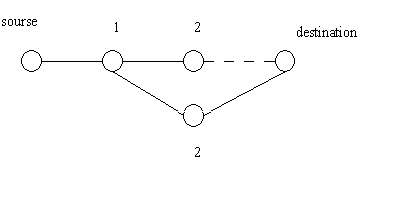
Analysis: It might be that some intermediary routers were rearrangeing
their views of topology,either
because of a new route becoming vailable or
existing route being lost(need more time to recover)
-
Fluttering (rapidly-oscillating routing)
In the experiment of the paper,they found that every other packet
from some border router travels via a
different route due to load spliting!
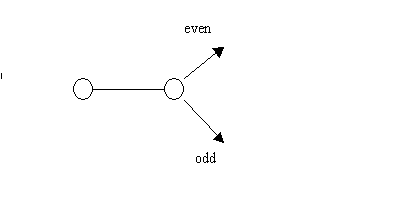
Problems
due to fluttering path: unstability,asymmetry,more difficult for estimation,unnecessary
retransmission
Routing Stability :
two terms:
-
Prevalence: how likely a route
r will be observed again in the future,which has implications
overall network
predictability.
-
Persistence: how long a route r will
be observed before changing,which has implications for
how to effectively
manage router state and for studies based on repeated path
measurements.
Examples:
1 1 1 1 2 1 1 1 1 1 1 2 1 1 1 1
prevalent,but not persistent
1 1 1 1 1 1 1 1 1 1 2 2 2 2 2 1 1 1 1 prevalent and persistent
Persistence for
longer time scales and shorter time scales:
Because a series of measurements at particular points do not necessarily
indicate
a lack of change, to
accurately assess persistence requires first determining if routing
alternates on short time scales.If not,
then the shortly spaced measurements can be used to assess on medium
time scales,etc.,and finally on
longer time scales.
Tightly-coupled
pair routers:
It is possible that frequent route changes differing at just a single
hop are due to shifting traffic between
two tightly coupled routers,then such pairs of routers can be merged
into a single router for purposes of
assessing of stability since such a change will have little consequence
provided they are co-located.
Example of flipping around the intermetiary routers:
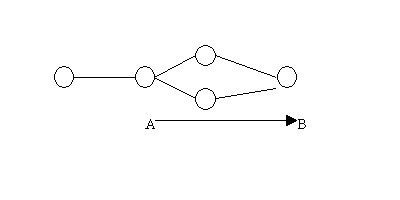
Question:How
many packets flow the path?
per-flow state,queue policy
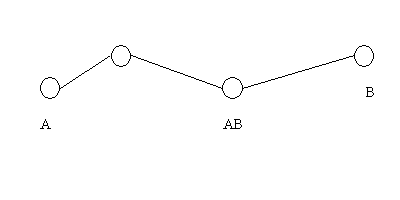
Routing Asymmetry
-
router asymmetry: different router
in both directions
city asymmetry: different cities
ISP asymmetry: different ISPs
*International routing: more asymmetry than intra-routing
A want packet to go directly to the boundary to B, not go
through A when it will have to "pay much"
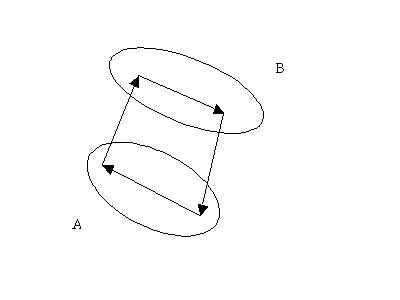
-
complications from asymmetry
. different cost metric for both directions
.one way delay will not be equal to half of RTT
.complicate network measurement&accouting.....




